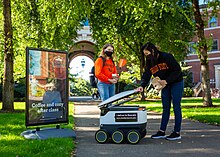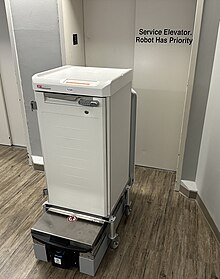An autonomous robot is a robot that acts without recourse to human control. Historic examples include space probes. Modern examples include self-driving vacuums and self-driving cars.
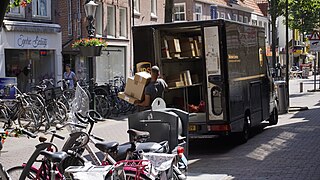
Package delivery or parcel delivery is the delivery of shipping containers, parcels, or high-value mail as single shipments. The service is provided by most postal systems, express mail, private courier companies, and less-than-truckload shipping carriers. Package delivery is different in each country, and how packages are delivered is closely connected with the cost for delivering to that country as well as population. In 2019, China, The United States, and Japan were the leaders in package delivery while Latvia, Macau, and Iceland were the bottom three. The population of the bottom three barely totals 2 million while the population of the top three tops totals more than 2 billion. Package delivery is an every day occurrence in the US while many other countries do not have this luxury.

Milton Keynes City Council is the local authority of the City of Milton Keynes in Buckinghamshire, England. It is a unitary authority, having the powers of a non-metropolitan county and district council combined. It has both borough status and city status. The borough, which extend beyond the ONS-defined Milton Keynes urban area and encompasses a substantial rural component, is divided into 19 wards, electing 57 councillors.
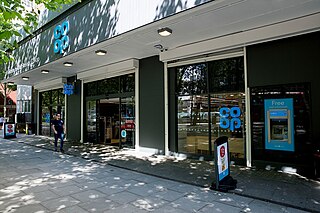
Co-op Food is a brand used for the food retail business of The Co-operative Group in the United Kingdom.
An online grocer is a supermarket or grocery store that allows ordering via websites or mobile apps. The order can either be collected by the customer or delivered to the customer by drivers engaged by the grocer, a food delivery service, or by delivery drones and robots.

Amazon Fresh is a subsidiary of the American e-commerce company Amazon in Seattle, Washington. It is a grocery retailer with physical stores and delivery services in most major U.S. cities, as well as some international cities, such as Berlin, Hamburg, London, Milan, Munich, Rome, Tokyo, and some other locations in Singapore and India.
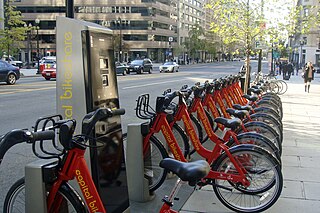
In supply chain management and transportation planning, the last mile or last kilometer is the last leg of a journey comprising the movement of passengers and goods from a transportation hub to a final destination. The concept of "last mile" was adopted from the telecommunications industry, which faced difficulty connecting individual homes to the main telecommunications network. Similarly, in supply chain management, last-mile describes the logistical challenges at the last phase of transportation getting people and packages from hubs to their final destinations.

A delivery drone is a unmanned aerial vehicle (UAV) designed to transport items such as packages, medicines, foods, postal mails, and other light goods. Large corporations like Amazon, DHL and FedEx have started to use drone delivery services. Drones were used effectively in the fight against COVID-19, delivering millions of vaccines and medical supplies across the globe. Drone deliveries are highly efficient, significantly speeding up delivery times and avoiding challenges traditional delivery vehicles may encounter. Given their life-saving potential use cases for medical supplies in particular have become the most widely-tested type of drone delivery, with trials and pilot projects in dozens of countries such as Australia, Canada, Botswana, Ghana, Uganda, the UK, the US among others.

Food delivery is a courier service in which a restaurant, store, or independent food-delivery company delivers food to a customer. An order is typically made either by telephone, through the supplier's website or mobile app, or through a third party food ordering service. The delivered items can include entrees, sides, drinks, desserts, or grocery items and are typically delivered in boxes or bags. The delivery person will normally drive a car, but in bigger cities where homes and restaurants are closer together, they may use bikes or motorized scooters.

Bolt is an Estonian mobility company that offers ride-hailing, micromobility rental, food and grocery delivery, and carsharing services. The company is headquartered in Tallinn and operates in over 500 cities in more than 45 countries in Europe, Africa, Western Asia and Latin America. The company has more than 150 million customers and more than 3 million driver and courier partners. The company has plans for an initial public offering in 2025.

Starship Technologies is an Estonian company developing autonomous delivery vehicles. The company is headquartered in San Francisco, California, with engineering operations in Tallinn, Estonia, and Helsinki, Finland. Starship also has offices in London, UK, Germany, Washington, DC, US, and Mountain View, California, US.

An automated convenience store is a convenience store that operates without a cashier, and instead relies on computers and robotics.

Oxa is an autonomous vehicle software company, headquartered in Oxfordshire, England, and founded by Paul Newman and Ingmar Posner.

Kar-go, is an autonomous delivery vehicle, designed and built by British company, Academy of Robotics Ltd, a UK company, registered in Wales. The vehicle uses self-drive / driverless car technology to drive itself to locations where it delivers packages autonomously.
Nuro, Inc. is an American robotics company based in Mountain View, California. Founded by Jiajun Zhu and Dave Ferguson, Nuro develops autonomous delivery vehicles and is the first company to receive an autonomous exemption from the National Highway Traffic Safety Administration.

Zipline International Inc. is an American company that designs, manufactures, and operates delivery drones. The company operates distribution centers in Rwanda, Ghana, Japan, the United States, Nigeria, Cote d'Ivoire, and Kenya. As of April 2024, its drones have made more than one million commercial deliveries and flown more than 70 million autonomous miles.
Robomart is an American technology company headquartered in Santa Monica, California that builds autonomous smart shops for cafes, ice cream parlors, and quick-service restaurants. The company’s white label platform gives retailers the option to expand their footprint at a significantly lower cost than traditional brick-and-mortar real-estate.

Yandex self-driving car is an autonomous car project of the Russian-based technology company Yandex. The first driverless prototype launched in May 2017. As of 2018, functional service was launched in Russia with prototypes also being tested in Israel and the United States. In 2019, Yandex revealed autonomous delivery robots based on the same technology stack as the company's self-driving cars. Since 2020, autonomous robots have been delivering food, groceries and parcels in Russia and the United States. In 2020, the self-driving project was spun-off into a standalone company under the name of Yandex Self-Driving Group.
Amazon Scout is a 6 wheeled delivery robot used to deliver packages for multinational company Amazon. Amazon Scout originally debuted on January 23, 2019, delivering packages to Amazon customers in Snohomish County, Washington. Amazon scouts move on sidewalks, at a walking pace. In August, 2019, the robots started delivering packages to customers Irvine, California on a test basis, with human monitors. The package is stored inside of the robot, and driven to the customer.
Academy of Robotics is a UK-based artificial intelligence technology company that creates technology to automate repetitive tasks and logistics.


